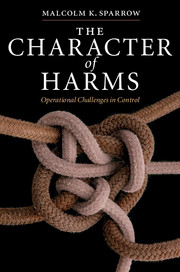Book contents
- Frontmatter
- Contents
- List of figures
- Acknowledgments
- Introduction
- Part I The nature of the control task
- 1 Which way up, and does it matter?
- 2 A different type of work
- 3 Defining problems: setting the scale
- 4 Defining problems: picking the dimensions
- 5 Patterns of thought and action
- 6 Puzzles of measurement
- 7 Structures, protocols, and interactions
- Part II Special categories of harms
- Conclusion
- Index
3 - Defining problems: setting the scale
from Part I - The nature of the control task
Published online by Cambridge University Press: 06 July 2010
- Frontmatter
- Contents
- List of figures
- Acknowledgments
- Introduction
- Part I The nature of the control task
- 1 Which way up, and does it matter?
- 2 A different type of work
- 3 Defining problems: setting the scale
- 4 Defining problems: picking the dimensions
- 5 Patterns of thought and action
- 6 Puzzles of measurement
- 7 Structures, protocols, and interactions
- Part II Special categories of harms
- Conclusion
- Index
Summary
The US Environmental Protection Agency (EPA), eager to make the best possible use of innovative programs, set up an Innovations Action Council (IAC) in the fall of 1996. The Council comprised all the senior managers of the agency from national and regional offices, gathered together once every quarter to focus on the EPA's use of innovative methods. The express purpose around which the Council gathered was framed this way:
The IAC's goal is to develop an innovations strategy that deploys innovative approaches and tools that make measurable progress on important environmental problems.
As a focal point for the IAC's discussions, this single sentence reflects both an appreciation of the need for innovative methods, and a conviction that innovation is not for its own sake but counts only when it makes a difference on problems that matter. Despite these positive ingredients, the sentence remains quite ambiguous about which of two quite different modes of organizational behavior it might produce. It can be read either forwards or backwards, and this simple choice significantly affects the operational consequences.
Reading the sentence forwards, the agency would begin by listing the innovative approaches and tools in its repertoire. Then, with these tools in mind, managers would proceed to search for important environmental problems where those tools might offer measurable progress. The starting point for such deliberation, therefore, is an expanded toolkit filled with tools the agency has already learned how to use.
Information
- Type
- Chapter
- Information
- The Character of HarmsOperational Challenges in Control, pp. 73 - 92Publisher: Cambridge University PressPrint publication year: 2008
